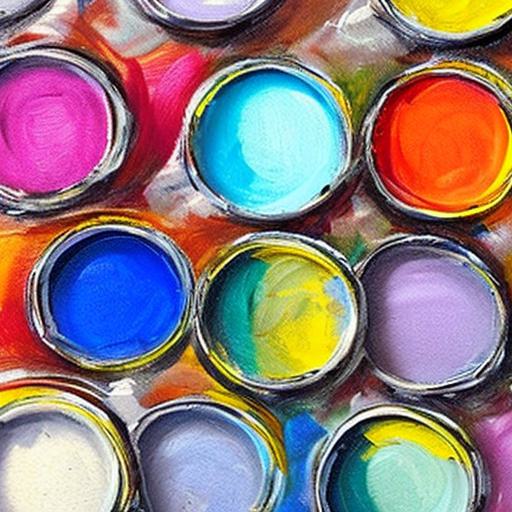If you’ve ever found yourself eagerly staring at a painting, waiting for the acrylic paint to dry so you can continue working or display your masterpiece, then this article is just for you. We all know the frustration of being limited by drying time, but fear not – there are simple yet effective techniques that can accelerate the drying process of acrylic paint. With these handy tips and tricks, you’ll be able to reduce the drying time and get back to creating art in no time.
Choose the Right Type of Acrylic Paint
When it comes to making your acrylic paint dry faster, the first step is to choose the right type of paint. Opting for fast-drying acrylic paint will significantly help speed up the drying process. Look for acrylic paints that are labeled as “fast-drying” or “quick-drying” to ensure that they dry in a timely manner. These paints are specifically formulated to dry faster than traditional acrylic paints, allowing you to complete your artwork more efficiently.
On the other hand, it is important to avoid using heavy-body acrylic paint if you’re looking to expedite the drying process. Heavy-body acrylics have a thicker consistency which can take longer to dry. Instead, opt for acrylic paints with a more fluid consistency as they tend to dry faster. Acrylic inks are also a great option to consider, as they are thinner and dry rapidly, allowing you to layer colors or create fine details without having to wait a long time for each layer to dry.
Additionally, choosing acrylic paint with a matte finish can help speed up the drying time. Matte acrylic paint tends to dry faster than paints with a glossy finish because the matte surface absorbs light, heat, and air more effectively. So, when purchasing acrylic paint, look for those that have a matte or satin finish to ensure a quicker drying process.
Prepare Your Painting Surface
The next step in making your acrylic paint dry faster is to prepare your painting surface properly. Choosing a porous or absorbent surface is crucial, as it allows the paint to soak in and dry more quickly. Materials such as canvas, wood, or paper are excellent choices for acrylic painting, as they absorb the paint efficiently.
Before starting your artwork, it is important to prime your painting surface. Priming creates a barrier between the surface and the paint, allowing the paint to adhere better and dry faster. Primers designed specifically for acrylic paints are readily available in art supply stores and come in various options, such as gesso or acrylic-based primers. Applying one or two layers of primer to your surface will help optimize the drying time of your acrylic paint.
It is worth noting that non-absorbent or glossy surfaces, such as glass or plastic, impede the drying process of acrylic paint. This is because these surfaces don’t allow the paint to penetrate or absorb properly. So, it is best to avoid painting directly on non-absorbent or glossy surfaces if you’re trying to accelerate the drying time of your acrylics.

Thin Your Acrylic Paint
To speed up the drying time of your acrylic paint, you can thin it out. There are several methods to achieve this, allowing the paint to dry faster and create lighter, translucent layers.
One way to thin your acrylic paint is by using a paint extender or medium. These products are specifically designed to thin heavy-body acrylic paints, allowing them to dry faster. Follow the instructions on the product’s label to properly mix the medium with your paint.
Alternatively, you can mix your acrylic paint with water to achieve a thinner consistency. This method is an affordable and easily accessible option for thinning your paint. However, be cautious not to use too much water, as it may weaken the paint’s adhesive properties and affect the overall quality of your artwork.
Control the Environment
Controlling the environment in which you paint can greatly influence the drying time of your acrylic paint. By creating the ideal conditions, you can expedite the drying process and achieve your desired results more quickly.
Increasing air circulation in your workspace is key to drying acrylic paint faster. Open windows or doors to allow fresh air to circulate, or use a fan to create a gentle breeze. This helps evaporate the moisture in the paint more rapidly, resulting in quicker drying times.
If you’re working in a humid environment, consider using a dehumidifier. High humidity can significantly prolong the drying time of your acrylic paint, so using a dehumidifier helps eliminate excess moisture from the air, allowing the paint to dry faster.
Another effective method to speed up the drying process is to place your painting near a fan or in direct sunlight. The moving air from a fan or the heat from direct sunlight helps to evaporate the water content in the paint more quickly, promoting faster drying.

Apply Thin Layers
When painting with acrylics, it is important to apply thin layers of paint to achieve faster drying times. Thick applications of paint tend to take longer to dry, as the paint needs more time to cure throughout the entire layer.
Instead of applying one thick layer, it is recommended to work with multiple thin layers. Each layer should be allowed to dry completely before adding the next one. This way, the moisture evaporates faster, and you can continue working on your artwork without having to wait for an extended period for each layer to dry.
By applying thin layers and ensuring proper drying time between each layer, you can build texture and depth in your artwork while still achieving faster drying times.
Use a Hairdryer or Heat Gun
If you’re looking to expedite the drying time of your acrylic paint, using a hairdryer or heat gun can be a handy technique. However, it is crucial to follow certain guidelines to prevent any damage to your artwork or the paint.
When using a hairdryer or heat gun, set it to the lowest or cool setting to avoid overheating the paint. High temperatures can cause the paint to crack, bubble, or even burn. By using a low or cool setting, you can apply gentle heat to speed up the drying process without risking any harm.
Keep the hairdryer or heat gun at a distance from the painting surface to distribute the heat evenly without concentrating it in one area. Moving the hairdryer or heat gun back and forth across the surface helps ensure an even drying process.
It is essential to avoid overheating the paint, so be cautious and use short bursts of heat rather than continuous, prolonged heat. This way, you can dry the paint faster while minimizing the risk of any damage to your artwork.

Try Acrylic Retarder
Acrylic retarder is a useful additive that slows down the drying time of acrylic paint. However, it can also be used to extend the drying time when desired. By mixing acrylic retarder into your paint, you can control the drying process and achieve the desired consistency and drying time.
It is important to note that acrylic retarder should be used sparingly to avoid excessive drying time. By experimenting with different ratios of acrylic retarder to paint, you can find the perfect balance that suits your needs and helps expedite the drying time of your artwork while still allowing for maneuverability and creative freedom.
Use Acrylic Additives
Acrylic additives are specifically designed to modify the properties of acrylic paint, including the drying time. By incorporating these additives into your paint, you can customize the drying time and consistency to your liking.
For faster drying times, add a touch of acrylic drying time extender to your paint. This additive helps accelerate the drying process without compromising the integrity or quality of the paint. Follow the manufacturer’s instructions regarding the appropriate amount to add to your paint.
Flow aid or leveling agents are other acrylic additives that can be helpful in speeding up the drying time. These additives help the paint flow more smoothly, allowing for faster and even drying. Again, it is crucial to follow the manufacturer’s instructions to achieve the desired results.
Always ensure you follow the instructions provided by the manufacturer when using acrylic additives to effectively and safely modify the drying time of your acrylic paint.
Consider Dry Time Accelerators
If you’re looking for a more convenient and readily available option to accelerate the drying time of your acrylic paint, consider using commercially available drying accelerators. These products are specifically designed to speed up the drying process, allowing you to complete your artwork in a shorter timeframe.
Make sure to carefully read and follow the instructions provided by the manufacturer when using drying accelerators. They may vary depending on the brand and product, so it is essential to use them as directed to achieve the best results.
While drying accelerators can be highly effective in reducing the drying time of acrylic paint, it is important to be aware of any potential side effects. Some accelerators may alter the sheen or consistency of the paint, so it is recommended to test them on a small area or sample piece before using them on your main artwork.
Apply Heat
Applying heat to your acrylic paint can significantly speed up the drying process. You can utilize methods such as a heat lamp or a heating pad to expedite the drying time of your artwork.
When using a heat lamp, position it a safe distance away from your painting surface to avoid overheating or damaging the paint. Keep in mind that excessive heat can cause the paint to bubble, crack, or even scorch, so it is important to be cautious and keep a close eye on your artwork while applying heat.
Heating pads are another option for applying gentle heat to your artwork. Place the heating pad underneath your painting surface and set it to a low or medium heat setting. Ensure that the heating pad is not in direct contact with the painting surface to avoid any potential damage.
While applying heat can be effective in drying acrylic paint faster, it is crucial to inform yourself about the associated risks and take necessary precautions to protect your artwork.
In conclusion, there are several methods and techniques you can use to make your acrylic paint dry faster. By choosing the right type of acrylic paint, preparing your painting surface properly, thinning the paint, controlling the environment, applying thin layers, using a hairdryer or heat gun, trying acrylic retarder or additives, considering drying accelerators, and applying gentle heat, you can significantly reduce the drying time of your acrylic paint and achieve your desired results more quickly. Remember to experiment and find the techniques that work best for you, allowing you to create beautiful artwork in less time.



